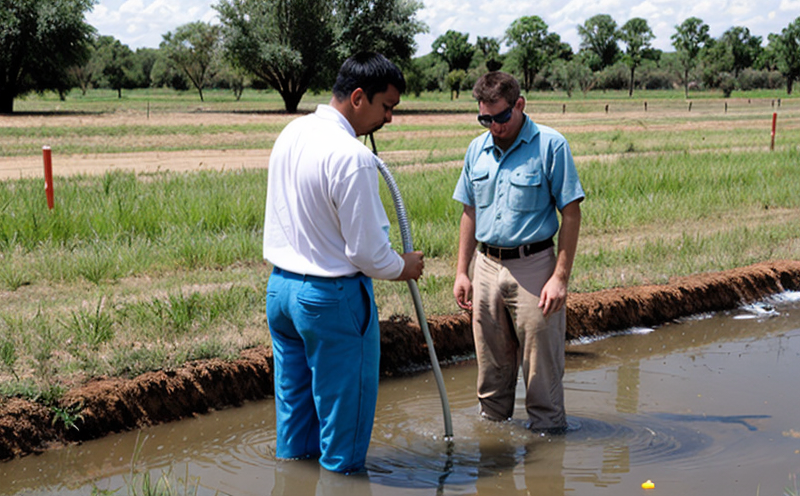EPA 335 Cyanide Determination Test in Groundwater
The EPA Method 335.2 is a critical protocol used by environmental laboratories to determine cyanide concentrations in water samples, including groundwater. This method is essential for ensuring compliance with federal and state regulations related to the presence of cyanide, which can be toxic to aquatic life and human health at elevated levels.
Groundwater plays a crucial role in many ecosystems and supplies drinking water for millions of people worldwide. Cyanide contamination can arise from various sources such as industrial processes, mining activities, or improper waste disposal. As such, accurate and reliable cyanide testing is vital to prevent environmental damage and protect public health. The EPA 335 test provides a standardized approach that ensures consistent results across different laboratories.
The testing process involves several steps: sample collection, preservation, transport, and analysis using gas chromatography or colorimetric methods. Proper sample handling is essential to avoid introducing errors into the analytical results. Preservation agents like sodium thiosulfate are used to stabilize the cyanide species in the sample before it reaches the laboratory.
The method's precision and accuracy are paramount for regulatory compliance. EPA 335 specifies strict quality assurance measures, including internal controls, inter-laboratory comparisons, and proficiency testing programs. These protocols ensure that results obtained by different laboratories are comparable and reliable.
Understanding the environmental implications of cyanide contamination is crucial. Cyanide can form complexes with metals in water, leading to toxicity for aquatic organisms. It can also be toxic to humans if ingested through contaminated drinking water or exposure during industrial processes. The EPA's stringent testing requirements help mitigate these risks by identifying and addressing potential issues early.
The cyanide determination test is part of a broader suite of environmental testing services aimed at safeguarding natural resources. By adhering to rigorous standards like EPA 335, laboratories contribute significantly to the protection of groundwater quality. This not only supports compliance with legal requirements but also promotes sustainable practices that benefit both the environment and society.
Benefits
- Compliance Assurance: Ensures adherence to environmental regulations by providing accurate cyanide concentration data.
- Risk Management: Identifies potential hazards associated with cyanide contamination, allowing for timely intervention and mitigation strategies.
- Data Reliability: Standardized testing methods ensure consistent and reliable results across different laboratories.
- Environmental Protection: By detecting cyanide levels early, this test helps prevent further environmental degradation.
Quality and Reliability Assurance
The EPA 335 method emphasizes the importance of quality control measures to ensure accurate results. Laboratories must establish internal protocols for sample handling, storage, and transportation to minimize potential errors. Regular calibration of equipment using certified reference materials is another key aspect of maintaining high-quality test outcomes.
Inter-laboratory comparisons and proficiency testing programs are essential components of this process. These activities allow laboratories to assess their performance against established benchmarks and identify areas for improvement. By participating in such programs, laboratories can enhance their credibility and reputation within the industry.
In addition to technical expertise, experienced personnel play a vital role in delivering reliable test results. Trained analysts familiar with EPA 335 procedures ensure that each step of the testing process is conducted correctly. Continuous training and updating knowledge base contribute significantly to maintaining proficiency levels.
Environmental laboratories committed to excellence also invest in state-of-the-art equipment and technologies. High-quality instrumentation supports precise measurements necessary for accurate determinations according to EPA guidelines.
Environmental and Sustainability Contributions
- Preventing Ecosystem Damage: Cyanide contamination can lead to significant harm to aquatic ecosystems, affecting biodiversity.
- Protecting Public Health: Ensuring clean drinking water is essential for maintaining public health standards globally.
- Sustainable Resource Management: By identifying and addressing cyanide issues early on, this test supports responsible use of natural resources.
- Promoting Compliance: Regulatory compliance helps maintain the integrity of environmental policies and practices.
The EPA 335 cyanide determination test is an integral part of sustainable development efforts. It plays a crucial role in safeguarding both human health and the environment by providing reliable data that informs decision-making processes at all levels—from local communities to international organizations.





